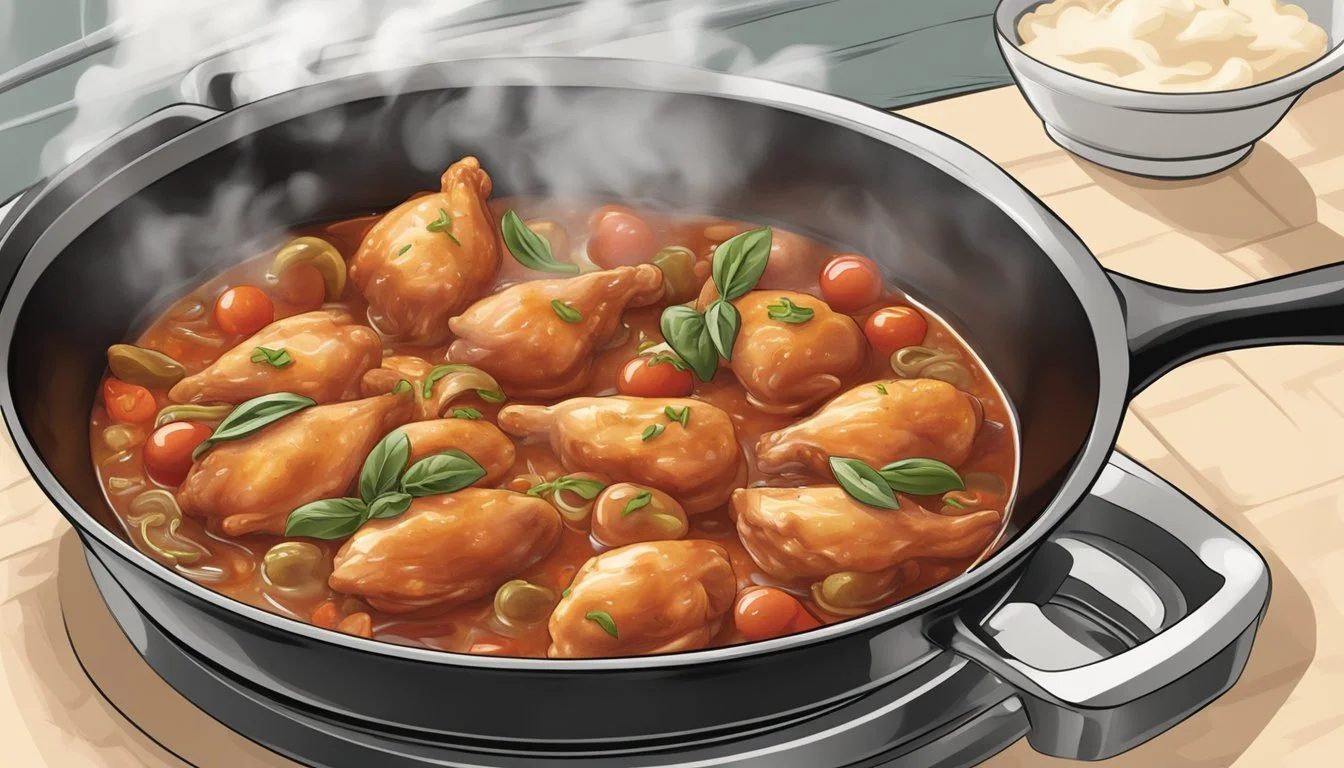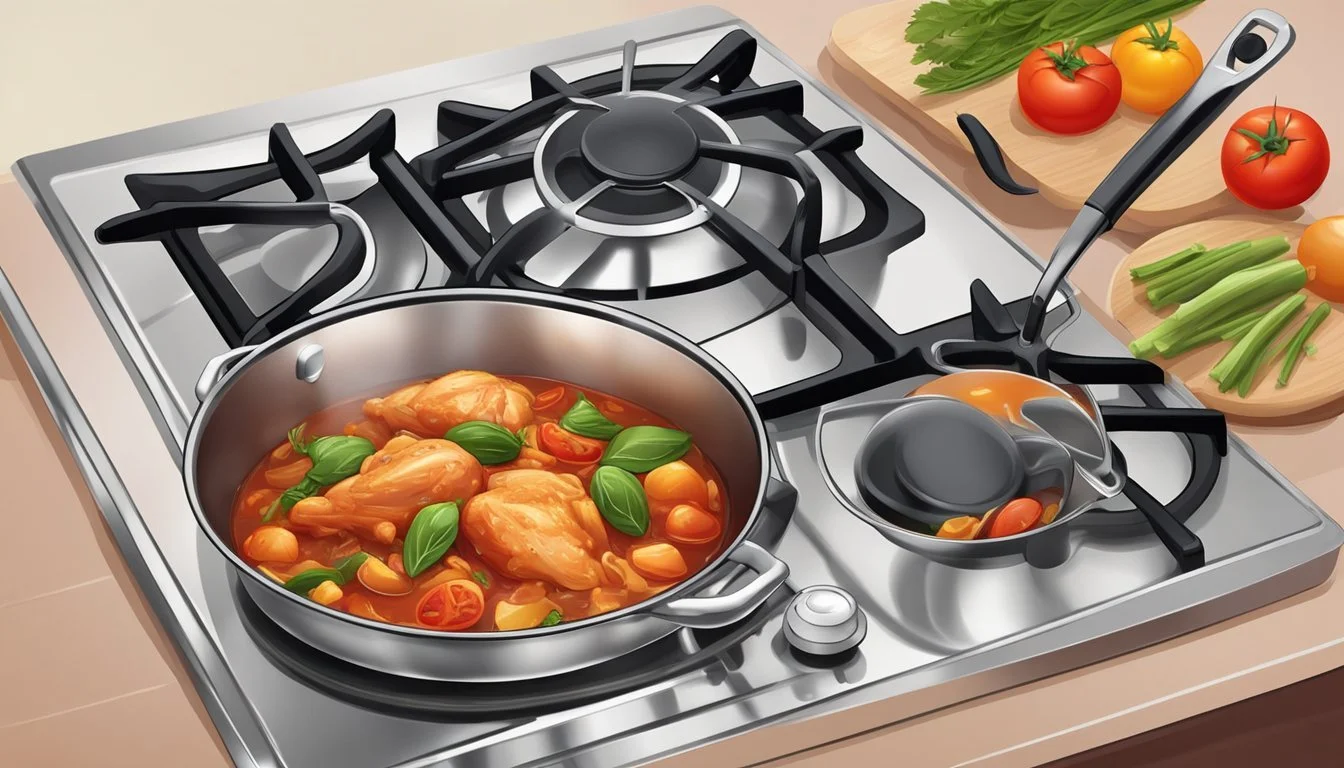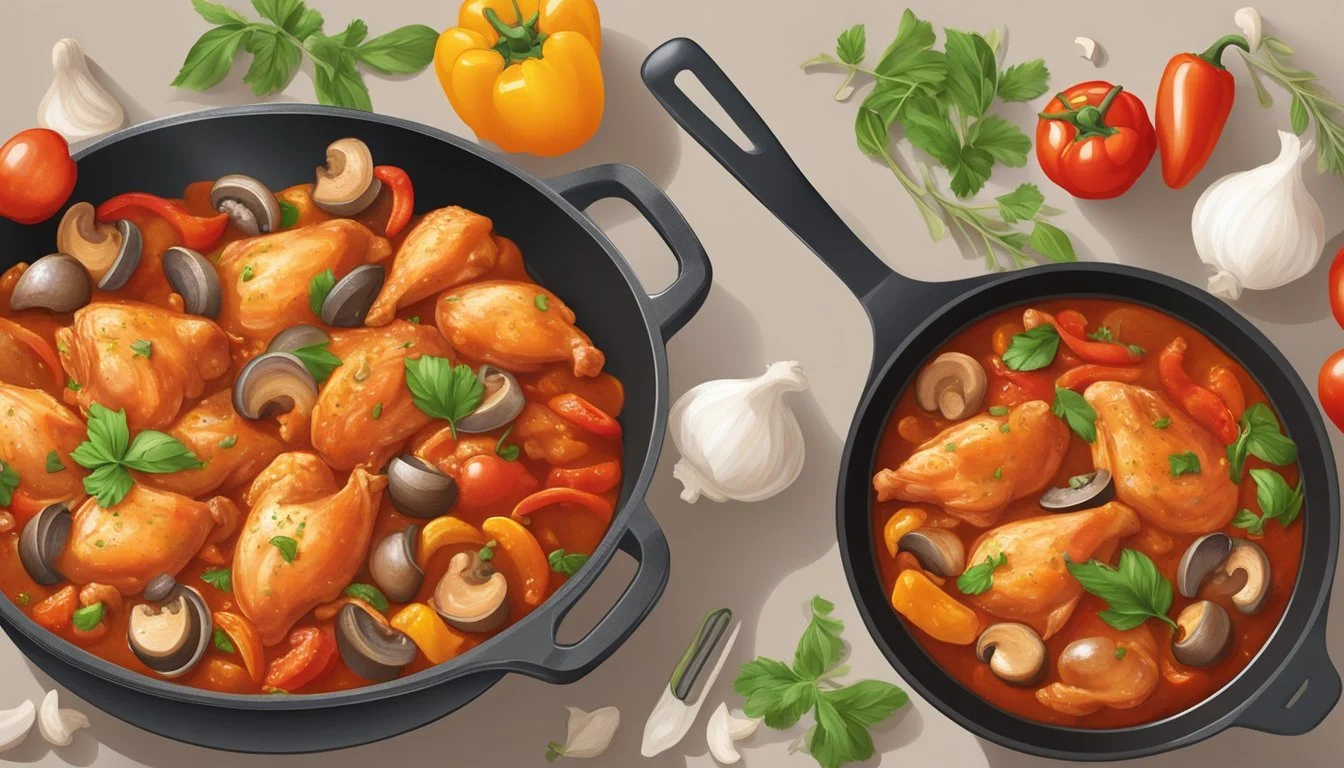Best Way to Reheat Chicken Cacciatore
Ensuring Tenderness & Richness
Reheating Chicken Cacciatore while preserving its tenderness and the robust flavor of its sauce is a matter of using the right method. This classic Italian dish, known for its rich and hearty sauce, requires careful reheating to ensure that the chicken does not dry out and the sauce remains as flavorful as when it was first cooked. The key is to gently warm the dish to an appropriate temperature while maintaining the integrity of its ingredients.
Microwave reheating is a common choice for its speed and convenience. However, it's essential to cover the chicken cacciatore with a microwave-safe lid or vented plastic wrap to contain moisture and prevent splattering. On the other hand, oven reheating is another effective way to warm up this dish. Covering the chicken cacciatore with foil can help retain moisture, and heating it to an internal temperature of 165°F ensures that it is warmed through.
For those who prefer an alternative to microwaving and oven heating, using an air fryer might be suitable. Wrapping the dish in foil and reheating it for a few minutes can yield results that are close to the initial cooking quality. Each method has its advantages, and selecting the right one will depend on the diner's time constraints and the equipment available.
Overview of Chicken Cacciatore
Chicken Cacciatore is a classic Italian dish known for its robust flavors and heartiness. It's a one-pot meal that combines tender chicken pieces with a rich tomato-based sauce and a variety of herbs and vegetables.
Origins and Culinary Tradition
Chicken Cacciatore, or "hunter's chicken," traces its origins to central Italy. The "hunter-style" preparation involved braising chicken with local ingredients such as onions, herbs, and tomatoes, which were readily available to the hunters. The dish has evolved over time and has been embraced in various regions of Italy, each adding its unique twist to the recipe. Rosemary, basil, and oregano are common herbs that enhance the dish's fragrance and depth of flavor.
Key Ingredients and Nutritional Value
The traditional recipe for Chicken Cacciatore includes chicken pieces simmered in a sauce made with olive oil, garlic, onions, bell peppers, and tomatoes, often enriched with white or red wine. Mushrooms and carrots are also frequently incorporated for additional texture and earthiness. Fresh herbs like basil, oregano, and thyme provide aromatic undertones.
From a nutritional standpoint, the dish is typically rich in protein, due to the chicken, while the vegetables contain various vitamins and fiber. The sauce's olive oil contributes healthy fats, although the dish's calorie and sodium content can vary depending on the preparation method and the portions of ingredients like salt and oil. Overall, Chicken Cacciatore can be a balanced meal that stands out for its medley of flavors and nutrients.
Preparing Chicken Cacciatore
When preparing Chicken Cacciatore, selecting the right ingredients and understanding their roles in the dish's flavor development are essential. The choice of chicken parts, wine, herbs, and vegetables all contribute to crafting an authentic hunter-style stew.
Choosing the Right Chicken Parts
The best chicken cacciatore recipe often recommends utilizing chicken thighs because they maintain tenderness and are less likely to dry out compared to breasts. They should be browned in olive oil to develop a rich flavor base.
The Role of Wine in Flavor Development
Red wine is integral to the cacciatore's sauce, imparting a depth of flavor. The alcohol in the wine evaporates during cooking, leaving behind a concentrated flavor that complements the tomatoes and garlic.
Herb Selection for Authentic Taste
Herbs like rosemary and parsley add layers of subtle, earthy notes to the dish. They should be fresh and finely chopped to fully release their essential oils into the sauce.
Vegetable Additions
Vegetables such as onions, carrots, and bell peppers are sautéed until soft. These veggies not only add texture but also sweetness and flavor to the cacciatore. Serving the dish on a bed of cooked rice can make for a hearty and satisfying meal.
Reheating Chicken Cacciatore
When reheating chicken cacciatore, maintaining the dish's moisture and flavor is imperative. There are multiple reheating methods, each having its own set of steps to ensure the meal remains as hearty and comforting as when it was first made.
Oven Reheating Methods
Preheat the Oven: The oven needs to be preheated to 350 degrees F (175 degrees C) before inserting the dish.
Prepare the Dish: Place the chicken cacciatore in an oven-safe dish. To maintain the moisture, one can add a few tablespoons of stock or water.
Cover: It's important to cover the dish with aluminum foil to keep the sauce from drying out and to evenly reheat the meat.
Reheat: Let the chicken cacciatore reheat for 20-30 minutes. Check that the internal temperature reaches 165°F (74°C) to ensure food safety.
Stovetop Techniques
Prep the Pan: One should use a pan that is large enough to hold the chicken and sauce comfortably.
Low Heat: To avoid overheating, they should warm the dish over low to medium heat.
Stirring Occasionally: It's crucial to stir the sauce and turn the chicken pieces occasionally for even reheating.
Simmer: Allow the dish to simmer gently until thoroughly warmed through.
Microwave Best Practices
Use Microwave-Safe Dish: They need to transfer the chicken cacciatore to a microwave-safe dish for reheating.
Cover with a Lid or Vented Wrap: To prevent messes and evenly distribute heat, cover the dish while leaving a small vent for steam to escape.
Reheat in Intervals: Using medium power, reheat in 30-second intervals, stirring in between to ensure even heating without overcooking.
Check for Consistent Temperature: Ensure the chicken reaches the necessary 165°F (74°C), which is the safe temperature for reheated poultry.
Maintaining Quality in Leftovers
Effective techniques in storing and reheating leftovers are crucial to retain the integrity of Chicken Cacciatore's rich flavors and moist texture.
Proper Storage and Freezing
One must prioritize airtight containment when storing leftover Chicken Cacciatore. Prior to freezing, cooling the dish completely is essential to maintain the quality of the sauce. Any residual warmth can lead to condensation, contributing to a watery consistency upon thawing.
How to Freeze:
Separate chicken from the cacciatore sauce, if possible.
Utilize freezer-safe containers or bags.
Label with freezing date for optimal freshness (freeze for up to 1-2 months).
Adding a small amount of olive oil to the sauce can help protect its texture and lock in moisture before freezing.
Thawing and Temperature Control
Safeguarding Chicken Cacciatore's quality also depends on proper thawing and reheating methods. To prevent bacterial growth, one should thaw the chicken in a refrigerator or use a cold water bath, ensuring the temperature remains safe and consistent.
Optimal Reheating Temperatures:
Thaw in the refrigerator for several hours or overnight.
Reheat to an internal temperature of 165°F (74°C) for safe consumption.
Reheating should be done gently; using a water bath can evenly distribute heat without drying out the chicken. When reheating in a microwave, covering the dish with a microwave-safe lid or vented plastic wrap can retain moisture and prevent splattering.
Complementary Side Dishes
Pairing the right side dishes with Chicken Cacciatore can elevate the meal, complementing the rich tomato sauce and tender chicken. Below, you'll find traditional Italian sides as well as versatile options for those with dietary restrictions.
Traditional Italian Sides
Italian cuisine is renowned for its bold flavors and comforting textures. Traditional sides often include a starch that balances the heartiness of Chicken Cacciatore.
Pasta: One cannot go wrong with serving Chicken Cacciatore over a bed of perfectly al dente pasta. It pairs well with a variety of pasta shapes, with spaghetti and linguine being among the most popular.
Rice: For those who prefer rice, a side of fluffy, garlic-infused rice complements the savory notes of the Cacciatore sauce. Adding a sprinkle of Parmesan cheese on top can enhance both the texture and flavor.
Crusty Bread: A slice of crusty bread serves not only as a vessel for the sauce but adds a pleasing textural contrast. One can also opt for garlic bread, lightly toasted and rubbed with fresh garlic.
Braised Potatoes: Potatoes, especially when braised or roasted with herbs, are a hearty option that absorbs the rich sauce delightfully.
Alternative Options for Dietary Restrictions
Catering to guests with dietary restrictions doesn't mean sacrificing flavor. Here are delectable alternatives:
Gluten-Free Pasta: Gluten-free pasta made from rice or other gluten-free grains is available for those avoiding gluten without compromising the Italian experience.
Mashed Potatoes: Garlic mashed potatoes can be made with olive oil instead of butter for a dairy-free version that remains creamy and satisfying.
Vegetables with Olives and Capers: A medley of sautéed vegetables such as zucchini or bell peppers, tossed with olives and capers, offers a flavorful and vibrant gluten-free side dish.
Choosing side dishes that match the flavor profile and dietary needs of your guests will ensure that the Chicken Cacciatore is truly the star of your meal.
Enhancing Flavor After Reheating
After reheating Chicken Cacciatore, the flavors can be rejuvenated and the dish's overall appeal can be significantly enhanced by thoughtful garnishing and seasoning. This section explores how to amplify the existing flavors and add a dimension of freshness to the dish.
Garnishing and Seasoning
To ensure the Chicken Cacciatore retains its richness and depth, a judicious application of seasoning is crucial. A pinch of salt and black pepper can awaken the flavors. Introducing fresh or dried herbs such as basil, oregano, and parsley complements the natural savoriness of the chicken. A subtle kick of spice can be achieved by sprinkling a few red pepper flakes, catering to those who appreciate a bit of heat.
One can never go wrong by finishing the dish with a drizzle of extra virgin olive oil, which binds flavors and adds a smooth, velvety texture. Here's a suggested list of garnishes that could take the dish to the next level:
Fresh basil leaves: To bring a vibrant pop of color and a hint of sweetness.
Dried oregano: For an astringent, earthy taste that melds well with the tomato-based sauce.
Parsley: Chopped finely for a fresh, grassy note.
Adding Freshness
Reinvigorating the Chicken Cacciatore with elements of freshness can transform the reheated dish into something that tastes freshly made. Incorporate thinly sliced basil leaves just before serving to infuse the dish with a fragrant aroma and a fresh, peppery taste. An addition of fresh herbs, picked right from the stalk, can do wonders by offering a contrast in texture and a burst of flavor that brightens the overall profile of the dish.
By folding in these fresh elements, one can restore the essence of the Chicken Cacciatore, making it a delightful experience for the palate as if it's been made from scratch.
Health Considerations When Reheating
Reheating chicken cacciatore can affect its nutritional value and its content of sodium, fats, and other dietary elements. The reader should pay close attention to these aspects to maintain the dish's health benefits while enjoying leftovers safely.
Nutrient Retention
When chicken cacciatore is reheated, it's important to preserve the integrity of proteins and carbohydrates. Proteins are crucial for body repair and maintenance, while carbohydrates provide energy. The key is to use gentle heating methods that minimize the degradation of these nutrients. The USDA recommends:
Avoid overheating, as it can reduce levels of certain B vitamins and vitamin C.
Reheat only until the internal temperature reaches 165°F to ensure food safety without overcooking.
Tips for Reducing Sodium and Fats
Chicken cacciatore is a flavorful dish that may contain considerable amounts of sodium and fats. However, one can employ strategies to reduce these elements while reheating:
Saturated Fat: Choose to remove any visible fat from the chicken before reheating to lower saturated fat content.
Cholesterol: Limit the use of additional fats like oils or butter when reheating, as the chicken and its sauce already contain cholesterol.
Sodium: For individuals watching their sodium intake, diluting the sauce with a small amount of low-sodium broth can help reduce the overall sodium content without significantly altering the flavor.
Calories: Monitor portion sizes when serving the reheated dish to control calorie intake.
By considering these factors, the heated dish can maintain much of its nutritional value while also adhering to health-conscious dietary choices.
Frequently Asked Questions
In this section, we address common concerns about reheating Chicken Cacciatore while preserving its tenderness and the rich taste of its sauce.
Selecting the Appropriate Reheating Method
When reheating Chicken Cacciatore, one's goal should be to retain the moisture of the chicken and the consistency of the sauce. For bone-in pieces like drumsticks or skinless chicken breasts, a skillet or a baking dish in the oven provides even heating without drying out the meat.
Skillet Method:
Heat a skillet over medium heat and add a touch of olive oil or butter to prevent sticking.
Place the chicken in the skillet, turning occasionally, until heated thoroughly.
Oven Method:
Preheat the oven to 350°F (175°C).
Place chicken in a baking dish in a single layer to allow for even heat distribution.
Add a splash of chicken broth or dry white wine to keep it moist, and cover with foil.
Adapting the Recipe for Different Diets
To cater to various dietary preferences, modifications using alternative ingredients can be made without compromising the integrity of this Italian comfort food.
For Gluten-Free: Substitute all-purpose flour with a gluten-free option to thicken the sauce.
For Dairy-Free: Replace butter with extra virgin olive oil and omit cheese such as parmesan.
For Extra Flavor: Add herbs or spices like garlic powder or black pepper, and consider sautéing celery and red pepper in extra virgin olive oil to include in the sauce.
When customizing the dish, one should ensure that the main flavors are consistent, employing the rich flavors of tomato paste, diced tomatoes, and dry white wine to maintain the essence of Chicken Cacciatore.
Final Tips and Tricks
In reheating Chicken Cacciatore to maintain its tenderness and the integrity of its rich sauce, one should consider the delicate balance of flavors and textures. The goal is to restore the dish to its original state of savory Italian excellence.
Serving Suggestions
When presenting reheated Chicken Cacciatore, it is important to complement the dish with appropriate sides to elevate its rustic charm. Serving it atop a bed of al dente pasta or with a side of crusty bread allows the sauce, thickened with flour and enriched with herbs like thyme and rosemary, to shine. One may also garnish with fresh herbs to refresh the dish's aroma and provide a contrast in color.
Recipe Variations for Personal Taste
Modifying Chicken Cacciatore for personal taste can involve adjusting the core components of its sauce. To enhance the depth of flavor, one might consider introducing a splash of red wine into the tomato sauce during the initial cooking phase. This melds well with the traditional Italian profile and intensifies the rustic nature of the dish. For those favoring a thicker sauce, a pinch of flour can be added while reheating to aid thickening. If a more aromatic touch is desired, additional rosemary and thyme can be simmered gently in the sauce as it reheats. Those utilizing a slow cooker may find that this method splendidly maintains moisture and tenderizes the chicken, as braising is an ideal technique for reheating without sacrificing texture.
Conclusion
Reheating chicken cacciatore carefully is crucial to maintain its tenderness and the richness of the sauce. Microwaving can offer convenience and speed, but for optimal results:
Transfer chicken cacciatore into a microwave-safe dish.
Use a microwave-safe lid or vented plastic wrap to cover the dish and prevent splatters.
Alternatively, an oven approach allows for a gradual reheat:
Preheat the oven to 350°F (175°C).
Place the chicken in an oven-safe dish and cover it with foil.
Heat for 15-20 minutes or until an internal temperature of 165°F (74°C) is reached.
Finally, a low oven temperature is recommended to reheat prosciutto-wrapped chicken, to prevent the meat from drying out and keeping the prosciutto crisp. Adding a small amount of liquid, such as chicken broth or a buttery white wine sauce, can infuse moisture without making the skin soggy. Use the following tips:
Add a small amount of liquid to the bottom of the foil package.
Reheat at a low oven temperature, around 325°F (about 163°C), checking the internal temperature to avoid overcooking.
By following these methods, one can preserve the moisture, flavor, and texture of the chicken, ensuring that the reheated dish is nearly as good as when it was first made.








